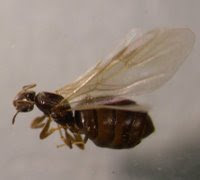Attention: We’re seeing a spike in swarming ants around Texas! We’ve written extensively about swarming ants before where we’ve talked about why they swarm and how to protect your property. Think of the swarmers as the “winged” ants you see floating in the pool, or dead around the window. After a successful, often mid-flight mating encounter, these winged reproductive ants will land, strip off their wings, and find a suitable place to start a new colony. Many ants like the contrast of colors provided by our manicured lawns and homes, and they settle down there (i.e. Swimming pools, sidewalks, driveways, and other areas where grass meets a different surface).

Rover Ant Swarmer – Photo by Micheal Merchant, Extension Entomologist and Professor, Texas AgriLife Extension, Texas A&M University System.
Many different species of ant that take to the sky when searching for a mate, typically after rainfall. See our other blog posts on swarming ants; Look Out for Flying Fire Ants, Have You Seen These Flying Ants, and 3 Signs of Flying Carpenter Ants.
Lately, more often that not, it’s been the Rover ant that we’ve seen. Kim Schofield of Texas A&M Agri life Extension writes a much more detailed and eloquent blog about the swarming rover ant than I could ever write. Read her post here about dark rover ants where she speaks to their behaviors and how to identify them. When we see rover ants in and around homes, we often find them close to a source of moisture. That could mean swimming pools, a leaky hot water heater, dripping faucets, all sorts of things.
As she states in her article, there are non-chemical means that can help with control for ants such as these, but often require the help of a professional to completely control an infestation. Rover ants can be challenging to control, but are included with our standard quarterly pest management services. People often mistake swarming ants for termites and believe they have an even worse problem on their hands. Luckily, a quick call to Venus Pest Company and we can set them straight!
